Kollam Junction railway station
Kollam Junction കൊല്ലം ജംഗ്ഷന് | |||||||||||||||||||||||||||||||||||||||||||||||||||||||||||||||||||||||||||||||||||||||||||||||||||||||||||||||||||||||||||||||||||||||||||||||||||||||||||||||||||||||||||||||||||||||||||||||||||||||||||||||||||||||
|---|---|---|---|---|---|---|---|---|---|---|---|---|---|---|---|---|---|---|---|---|---|---|---|---|---|---|---|---|---|---|---|---|---|---|---|---|---|---|---|---|---|---|---|---|---|---|---|---|---|---|---|---|---|---|---|---|---|---|---|---|---|---|---|---|---|---|---|---|---|---|---|---|---|---|---|---|---|---|---|---|---|---|---|---|---|---|---|---|---|---|---|---|---|---|---|---|---|---|---|---|---|---|---|---|---|---|---|---|---|---|---|---|---|---|---|---|---|---|---|---|---|---|---|---|---|---|---|---|---|---|---|---|---|---|---|---|---|---|---|---|---|---|---|---|---|---|---|---|---|---|---|---|---|---|---|---|---|---|---|---|---|---|---|---|---|---|---|---|---|---|---|---|---|---|---|---|---|---|---|---|---|---|---|---|---|---|---|---|---|---|---|---|---|---|---|---|---|---|---|---|---|---|---|---|---|---|---|---|---|---|---|---|---|---|---|
| Junction station | |||||||||||||||||||||||||||||||||||||||||||||||||||||||||||||||||||||||||||||||||||||||||||||||||||||||||||||||||||||||||||||||||||||||||||||||||||||||||||||||||||||||||||||||||||||||||||||||||||||||||||||||||||||||
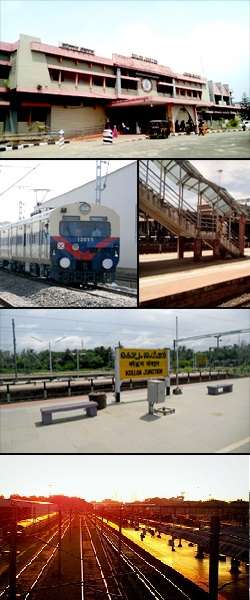 From Top: Entrance of Kollam Junction Railway Station, A MEMU train at Kollam railway station, Foot over bridge, Name board of the station, Kollam MEMU Shed building | |||||||||||||||||||||||||||||||||||||||||||||||||||||||||||||||||||||||||||||||||||||||||||||||||||||||||||||||||||||||||||||||||||||||||||||||||||||||||||||||||||||||||||||||||||||||||||||||||||||||||||||||||||||||
| Location |
Kollam, Kollam District, Kerala India | ||||||||||||||||||||||||||||||||||||||||||||||||||||||||||||||||||||||||||||||||||||||||||||||||||||||||||||||||||||||||||||||||||||||||||||||||||||||||||||||||||||||||||||||||||||||||||||||||||||||||||||||||||||||
| Coordinates | 8°53′10″N 76°35′42″E / 8.8860°N 76.5951°ECoordinates: 8°53′10″N 76°35′42″E / 8.8860°N 76.5951°E | ||||||||||||||||||||||||||||||||||||||||||||||||||||||||||||||||||||||||||||||||||||||||||||||||||||||||||||||||||||||||||||||||||||||||||||||||||||||||||||||||||||||||||||||||||||||||||||||||||||||||||||||||||||||
| Elevation | 6.74 metres (22.1 ft) | ||||||||||||||||||||||||||||||||||||||||||||||||||||||||||||||||||||||||||||||||||||||||||||||||||||||||||||||||||||||||||||||||||||||||||||||||||||||||||||||||||||||||||||||||||||||||||||||||||||||||||||||||||||||
| Owned by | Indian Railways | ||||||||||||||||||||||||||||||||||||||||||||||||||||||||||||||||||||||||||||||||||||||||||||||||||||||||||||||||||||||||||||||||||||||||||||||||||||||||||||||||||||||||||||||||||||||||||||||||||||||||||||||||||||||
| Operated by | Southern Railway zone | ||||||||||||||||||||||||||||||||||||||||||||||||||||||||||||||||||||||||||||||||||||||||||||||||||||||||||||||||||||||||||||||||||||||||||||||||||||||||||||||||||||||||||||||||||||||||||||||||||||||||||||||||||||||
| Line(s) |
•Kollam Junction-Thiruvananthapuram Central •Kollam Junction-Ernakulam Junction (via Alappuzha and Kottayam) •Kollam Junction-Sengottai | ||||||||||||||||||||||||||||||||||||||||||||||||||||||||||||||||||||||||||||||||||||||||||||||||||||||||||||||||||||||||||||||||||||||||||||||||||||||||||||||||||||||||||||||||||||||||||||||||||||||||||||||||||||||
| Platforms | 6 (1A,1,2,3,4,5) | ||||||||||||||||||||||||||||||||||||||||||||||||||||||||||||||||||||||||||||||||||||||||||||||||||||||||||||||||||||||||||||||||||||||||||||||||||||||||||||||||||||||||||||||||||||||||||||||||||||||||||||||||||||||
| Tracks | 17 | ||||||||||||||||||||||||||||||||||||||||||||||||||||||||||||||||||||||||||||||||||||||||||||||||||||||||||||||||||||||||||||||||||||||||||||||||||||||||||||||||||||||||||||||||||||||||||||||||||||||||||||||||||||||
| Connections |
| ||||||||||||||||||||||||||||||||||||||||||||||||||||||||||||||||||||||||||||||||||||||||||||||||||||||||||||||||||||||||||||||||||||||||||||||||||||||||||||||||||||||||||||||||||||||||||||||||||||||||||||||||||||||
| Construction | |||||||||||||||||||||||||||||||||||||||||||||||||||||||||||||||||||||||||||||||||||||||||||||||||||||||||||||||||||||||||||||||||||||||||||||||||||||||||||||||||||||||||||||||||||||||||||||||||||||||||||||||||||||||
| Structure type | Standard (on ground station) | ||||||||||||||||||||||||||||||||||||||||||||||||||||||||||||||||||||||||||||||||||||||||||||||||||||||||||||||||||||||||||||||||||||||||||||||||||||||||||||||||||||||||||||||||||||||||||||||||||||||||||||||||||||||
| Platform levels | 01 | ||||||||||||||||||||||||||||||||||||||||||||||||||||||||||||||||||||||||||||||||||||||||||||||||||||||||||||||||||||||||||||||||||||||||||||||||||||||||||||||||||||||||||||||||||||||||||||||||||||||||||||||||||||||
| Parking |
| ||||||||||||||||||||||||||||||||||||||||||||||||||||||||||||||||||||||||||||||||||||||||||||||||||||||||||||||||||||||||||||||||||||||||||||||||||||||||||||||||||||||||||||||||||||||||||||||||||||||||||||||||||||||
| Bicycle facilities |
| ||||||||||||||||||||||||||||||||||||||||||||||||||||||||||||||||||||||||||||||||||||||||||||||||||||||||||||||||||||||||||||||||||||||||||||||||||||||||||||||||||||||||||||||||||||||||||||||||||||||||||||||||||||||
| Disabled access |
| ||||||||||||||||||||||||||||||||||||||||||||||||||||||||||||||||||||||||||||||||||||||||||||||||||||||||||||||||||||||||||||||||||||||||||||||||||||||||||||||||||||||||||||||||||||||||||||||||||||||||||||||||||||||
| Other information | |||||||||||||||||||||||||||||||||||||||||||||||||||||||||||||||||||||||||||||||||||||||||||||||||||||||||||||||||||||||||||||||||||||||||||||||||||||||||||||||||||||||||||||||||||||||||||||||||||||||||||||||||||||||
| Status | Functioning | ||||||||||||||||||||||||||||||||||||||||||||||||||||||||||||||||||||||||||||||||||||||||||||||||||||||||||||||||||||||||||||||||||||||||||||||||||||||||||||||||||||||||||||||||||||||||||||||||||||||||||||||||||||||
| Station code | QLN | ||||||||||||||||||||||||||||||||||||||||||||||||||||||||||||||||||||||||||||||||||||||||||||||||||||||||||||||||||||||||||||||||||||||||||||||||||||||||||||||||||||||||||||||||||||||||||||||||||||||||||||||||||||||
| Zone(s) | Southern Railway zone | ||||||||||||||||||||||||||||||||||||||||||||||||||||||||||||||||||||||||||||||||||||||||||||||||||||||||||||||||||||||||||||||||||||||||||||||||||||||||||||||||||||||||||||||||||||||||||||||||||||||||||||||||||||||
| Division(s) | Thiruvananthapuram | ||||||||||||||||||||||||||||||||||||||||||||||||||||||||||||||||||||||||||||||||||||||||||||||||||||||||||||||||||||||||||||||||||||||||||||||||||||||||||||||||||||||||||||||||||||||||||||||||||||||||||||||||||||||
| History | |||||||||||||||||||||||||||||||||||||||||||||||||||||||||||||||||||||||||||||||||||||||||||||||||||||||||||||||||||||||||||||||||||||||||||||||||||||||||||||||||||||||||||||||||||||||||||||||||||||||||||||||||||||||
| Opened | June 1, 1904 | ||||||||||||||||||||||||||||||||||||||||||||||||||||||||||||||||||||||||||||||||||||||||||||||||||||||||||||||||||||||||||||||||||||||||||||||||||||||||||||||||||||||||||||||||||||||||||||||||||||||||||||||||||||||
| Electrified | 25 kV AC 50 Hz | ||||||||||||||||||||||||||||||||||||||||||||||||||||||||||||||||||||||||||||||||||||||||||||||||||||||||||||||||||||||||||||||||||||||||||||||||||||||||||||||||||||||||||||||||||||||||||||||||||||||||||||||||||||||
| Previous names | Quilon Junction Railway Station | ||||||||||||||||||||||||||||||||||||||||||||||||||||||||||||||||||||||||||||||||||||||||||||||||||||||||||||||||||||||||||||||||||||||||||||||||||||||||||||||||||||||||||||||||||||||||||||||||||||||||||||||||||||||
| Traffic | |||||||||||||||||||||||||||||||||||||||||||||||||||||||||||||||||||||||||||||||||||||||||||||||||||||||||||||||||||||||||||||||||||||||||||||||||||||||||||||||||||||||||||||||||||||||||||||||||||||||||||||||||||||||
| Passengers (2017-18) | 23,048 per day[1] | ||||||||||||||||||||||||||||||||||||||||||||||||||||||||||||||||||||||||||||||||||||||||||||||||||||||||||||||||||||||||||||||||||||||||||||||||||||||||||||||||||||||||||||||||||||||||||||||||||||||||||||||||||||||
| Rank |
4 (in Kerala) 3 (in Trivandrum division) | ||||||||||||||||||||||||||||||||||||||||||||||||||||||||||||||||||||||||||||||||||||||||||||||||||||||||||||||||||||||||||||||||||||||||||||||||||||||||||||||||||||||||||||||||||||||||||||||||||||||||||||||||||||||
| Services | |||||||||||||||||||||||||||||||||||||||||||||||||||||||||||||||||||||||||||||||||||||||||||||||||||||||||||||||||||||||||||||||||||||||||||||||||||||||||||||||||||||||||||||||||||||||||||||||||||||||||||||||||||||||
| |||||||||||||||||||||||||||||||||||||||||||||||||||||||||||||||||||||||||||||||||||||||||||||||||||||||||||||||||||||||||||||||||||||||||||||||||||||||||||||||||||||||||||||||||||||||||||||||||||||||||||||||||||||||
| |||||||||||||||||||||||||||||||||||||||||||||||||||||||||||||||||||||||||||||||||||||||||||||||||||||||||||||||||||||||||||||||||||||||||||||||||||||||||||||||||||||||||||||||||||||||||||||||||||||||||||||||||||||||
| Location | |||||||||||||||||||||||||||||||||||||||||||||||||||||||||||||||||||||||||||||||||||||||||||||||||||||||||||||||||||||||||||||||||||||||||||||||||||||||||||||||||||||||||||||||||||||||||||||||||||||||||||||||||||||||
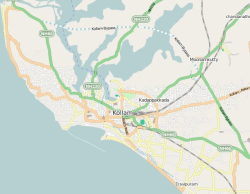 Kollam Junction railway station Location within Kollam 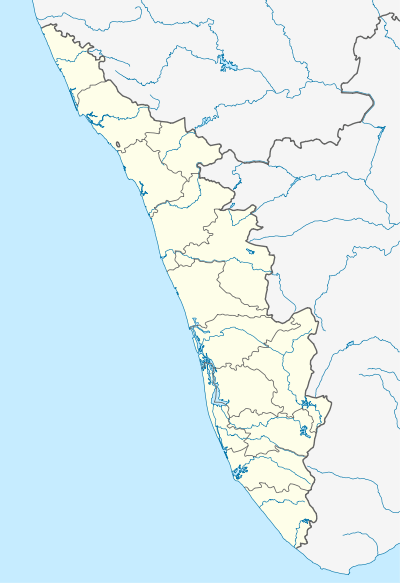 Kollam Junction railway station Kollam Junction railway station (Kerala)  Kollam Junction railway station Kollam Junction railway station (India)  Kollam Junction railway station Kollam Junction railway station (Asia) | |||||||||||||||||||||||||||||||||||||||||||||||||||||||||||||||||||||||||||||||||||||||||||||||||||||||||||||||||||||||||||||||||||||||||||||||||||||||||||||||||||||||||||||||||||||||||||||||||||||||||||||||||||||||
Kollam Junction railway station (station code: QLN) is a junction station situated in the city of Kollam in Kerala, India. It is the second largest railway station in Kerala in terms of area and is one of the oldest railway stations in the state. World's second longest railway platform is situated at Kollam railway station.[2][3][4]
Kollam Junction lies on Kollam-Thiruvananthapuram trunk line. It is operated by the Southern Railway Zone of the Indian Railways and comes under the Thiruvananthapuram railway division. The annual passenger ticket revenue of Kollam railway station is ₹64.23 crore (US$8.9 million) and 23,048 is the daily ridership through this station.[5]
History
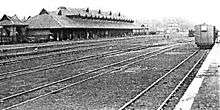
Kollam was the fifth city in Kerala to be connected to the nascent Indian Railway. The idea of a rail link from Tirunelveli to Kollam, then the trading capital of the Travancore Kingdom was first conceived in 1873. The line was sanctioned by the Madras Presidency in 1899 and a survey completed in 1900. The railway line was built jointly by South Indian railway, Travancore state and the Madras Presidency. Kollam's (in English - Quilon) railway station was built in 1904 by Sree Moolam Tirunal Rama Varma, Maharaja of Travancore. It was the ruler’s desire to create a rail link between Kollam, the then commercial capital of his State and Madras.[6] The meter gauge line from Kollam to Punalur was inaugurated on 1 June 1904. The Kollam-Sengottai railway line was inaugurated on 26 November 1904. The meter gauge line was later extended to Chala at Trivandrum via Paravur and Varkala and inaugurated on 4 January 1918.[7] The meter gauge railway line from Kollam was extended to Ernakulam via Kottayam on 6 January 1958. The meter gauge lines between Kollam and Ernakulam were converted to broad gauge in 1975 and inaugurated on 13 September 1976. The broad gauge conversion between the Punalur and Kollam sections was inaugurated on 12 May 2010.
There was once a 2.4 kilometres (1.5 mi) meter gauge line connecting Quilon Junction and Ashramam Maidan. During the inauguration of the Kollam-Punalur meter gauge line in 1904, parts of locomotives which were to be used for Quilon-Schencottah line were shipped to Quilon Port from Tuticorin Port. They were assembled at the Ashramam Maidan, which was an open ground. The line was laid to carry these locomotives to the main station. The line was dismantled in 2000 to allow for town expansion.
Layout
There are a total of 17 tracks in the Kollam railway station, 2 lines are passing through the MEMU shed. The station has 6 platforms for handling long distance, passenger, MEMU & goods trains. The platform 1 is divided into two sections. Platform 1A handles the trains to Punalur-Sengottai line and platform 1 handles trains towards Trivandrum Central. The platform 1 and 1A together have a length of 1,180.5 m making them together the second longest railway platform in India.[8] The station has a MEMU shed which is situated near to Platform 1A. An FCI godown owned and operated by Food Corporation of India is also situated near Kollam junction.
| Railways in Kerala cities |
|---|
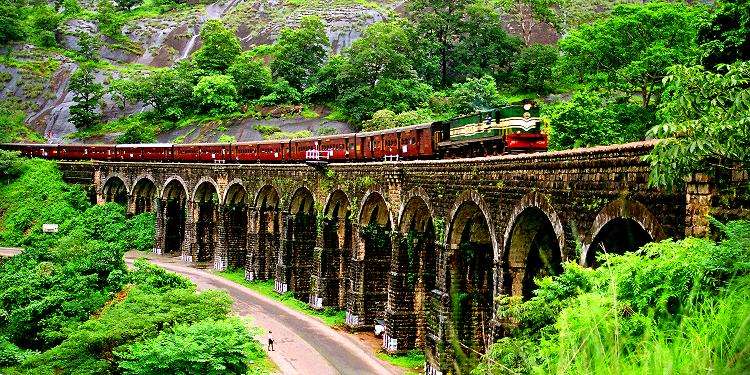 |
Location
Surrounding transport hubs:[9]
- Nearest Bus Stations: Andamukkam City Bus Stand (1.2 km) & Kollam KSRTC Bus Station (2 km)
- Nearest Sea Port: Kollam Port (3 km)
- Nearest Ferry Terminal: Kollam KSWTD Ferry Terminal (2 km)
- Nearest Airport: Trivandrum International Airport (67 km) & Kollam Helipad(Old Airport) (0.5 km)
Annual passenger earnings
The annual passenger earnings from Kollam railway station shows a steady growth for several decades.[10]
| Year | Earnings (in crores) |
Variation |
|---|---|---|
| 2011-12 | ₹38.2105 crore (US$5.3 million) | NA |
| 2012–13 | ₹43.8898 crore (US$6.1 million) | ₹5.6793 crore (US$790,000) |
| 2013–14 | ₹49.5695 crore (US$6.9 million) | ₹5.6797 crore (US$790,000) |
| 2014–15 | ₹56.2797 crore (US$7.8 million) | ₹6.7102 crore (US$930,000) |
| 2015–16 | ₹60.4467 crore (US$8.4 million) | ₹4.167 crore (US$580,000) |
| 2016-17 | ₹60.7804 crore (US$8.5 million) | ₹0.3337 crore (US$46,000)[11][12] |
| 2017-18 | ₹64.2310 crore (US$8.9 million) | ₹3.4506 crore (US$480,000)[13] |
MEMU Shed
Kollam MEMU Carshed is constructed at a cost of ₹40.68 crore (US$5.7 million), for Mainline Electric Multiple Unit (MEMU) rakes. It was formally commissioned on 1 December 2013, five years after its completion.[14] Now the railways is operating 3 pair of Kollam-Ernakulam (via Alappuzha and Kottayam)[15] via both the routes and a Kollam-Kanyakumari[16] (via Trivandrum, Nagercoil) services from Kollam. Kollam MEMU Shed is the largest MEMU Shed in Kerala, which is equipped with most modern facilities.
Future
Construction works for the second terminal at Kollam Junction station is inaugurated by Union Minister for Railways Suresh Prabhu on 12 February 2016 and is expected to complete by October 2018.[17][18] The modernization works of the old terminal including works for lifts, escalators, new air conditioned waiting area etc. have been initiated in the railway station but not yet completed.
- Google's High-speed Wi-Fi service
Kollam is among the first 100 railway stations in India selected for providing high-speed Wi-Fi services by Google, named as ‘Project Nilgiri’. There are 5 railway stations from Kerala in the initial stage.[19][20][21][22][23] The service inaugurated at Kollam station on 26 December 2016 by Suresh Prabhu, Railway Minister of India, through video conferencing.[24][25][26][27][28]
Incident
Other suburban railway stations
| No. | Station | Code | Area | Distance from Kollam Jn. |
|---|---|---|---|---|
| 1 | Perinad | PRND | North Kollam | 9.1 km |
| 2 | Karunagappalli | KPY | North Kollam | 27.1 km |
| 3 | Ochira | OCR | North Kollam | 34.8 km |
| 4 | Kilikollur | KLQ | East Kollam | 5.6 km |
| 5 | Chandanathoppe | CTPE | East Kollam | 7.3 km |
| 6 | Kundara | KUV | East Kollam | 12.7 km |
| 7 | Eravipuram | IRP | South Kollam | 4.6 km |
| 8 | Mayyanad | MYY | South Kollam | 8.9 km |
| 9 | Paravur | PVU | South Kollam | 12.4 km |
See also
| Wikimedia Commons has media related to Kollam Junction railway station. |
References
- ↑ "Annual originating passengers and earnings for the year 2017-18 - Thiruvananthapuram Division" (PDF). Indian Railways. Retrieved 11 September 2018.
- ↑ "At a glance: Longest railway platforms in India". Railnewscenter. Archived from the original on 25 February 2015. Retrieved 25 February 2015.
- ↑ "The Top 6 Longest Railway Platforms of India". Walk through India. Retrieved 25 February 2015.
- ↑ "West Bengal: tea plantations and other Raj-era relics".
- ↑ "Annual originating passengers and earnings for the year 2017-18 - Thiruvananthapuram Division" (PDF). Indian Railways. Retrieved 11 September 2018.
- ↑ A station of yore, its golden links
- ↑ Railways cross a milestone
- ↑ "Current Affairs: Longest Railway Platforms".
- ↑ https://maps.google.co.in/maps?hl=en&tab=wl
- ↑ "Station Redevelopment Plan - Kollam Junction". Indian Railways. Retrieved 10 July 2017.
- ↑ "Stations Profile 2017 - Thiruvananthapuram Division" (PDF). Indian Railways. Retrieved 14 March 2018.
- ↑ "RTI reply about Annual Passenger Ticket Revnue 2015-16 : Kollam Junction". Indian Railways. Retrieved 10 July 2017.
- ↑ "Annual originating passengers and earnings for the year 2017-18 - Thiruvananthapuram Division" (PDF). Indian Railways. Retrieved 11 September 2018.
- ↑ MEMU Maintenance Work Begins in Kollam Kollam MEMU Shed
- ↑ MEMU service flagged off Kollam-Ernakulam MEMU
- ↑ MEMU service flagged off in Kollam Kollam-Kanyakumari MEMU
- ↑ "Kollam second terminal by October". Kollam: The Hindu. 31 May 2018. Retrieved 1 June 2018.
- ↑ "New entry for rail station". Retrieved 12 February 2016.
- ↑ "These 5 Railway stations in Kerala will first get Google's Wi-Fi! Is your city among the list?". Retrieved 9 October 2015.
- ↑ "Experience high speed Wi-Fi at Trivandrum Central railway station". 30 October 2016. Retrieved 31 October 2016.
- ↑ "Central station is Wi-Fi hotspot now - The Hindu". 29 October 2016. Retrieved 31 October 2016.
- ↑ "Surf the rail net for free from Thiruvananthapuram station - The New Indian Express". 29 October 2016. Retrieved 31 October 2016.
- ↑ "Wi-Fi in three more Kerala railway stations soon - The Hindu". 27 April 2016. Retrieved 31 October 2016.
- ↑ "Free Wi-Fi service at 100 railway stations, Kollam latest to be enabled". 27 December 2016. Retrieved 27 December 2016.
- ↑ "Railway WiFi: 100 stations now WiFi enabled, another 300 planned for 2017". 27 December 2016. Retrieved 27 December 2016.
- ↑ "Free Wi-Fi service at 100 railway stations". The dayafter. 27 December 2016. Retrieved 28 December 2016.
- ↑ "Free Wi-Fi service at 100 railway stations, including Kollam". Mathrubhumi. 27 December 2016. Retrieved 28 December 2016.
- ↑ "Free Wi-Fi service now available at 100 railway stations across India, 400 stations to be covered next year". Economic Times. 27 December 2016. Retrieved 28 December 2016.
- ↑ []
- ↑ []